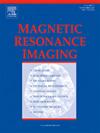回复“通过水质子的各向异性弛豫测量揭示软骨纳米结构:可行性还是谬误?”
IF 2
4区 医学
Q2 RADIOLOGY, NUCLEAR MEDICINE & MEDICAL IMAGING
引用次数: 0
摘要
本复函解决了由Y. Pang, K. Momot和V. Mlynárik(磁共振成像,123,2025,110508)所写的题为“通过水质子的各向异性松弛测量揭示软骨纳米结构:可行性还是谬论?”的信函中提出的问题。前一封信的作者声称,我们在论文《利用MRI信号衰减表征软骨纳米结构的深度依赖》(Magnetic Resonance Imaging, 120,2025, 110395)中提出的模型和理论结果是不正确的。在这里,我们证明了我们的模型是基于使用各种方法获得的理论和实验数据,并且我们的结果与先前发表的研究结果一致。我们开发的方法允许组织结构:估计椭球状充满水的纳米腔的体积,它们的角分布,以及这些特征随深度的变化。新方法与早期发表的研究的主要区别在于,这些特征是使用单个NMR/MRI信号(回声衰减)而无需样品旋转获得的。我们相信我们的结果有助于更好地理解与MRI信号和组织纳米结构相关的复杂问题。本文章由计算机程序翻译,如有差异,请以英文原文为准。
Reply to “Unveiling cartilage nanostructures via anisotropic relaxometry of water protons: feasibility or fallacy?”
This Reply addresses the issues raised in the Letter, entitled “Unveiling Cartilage Nanostructures via Anisotropic Relaxometry of Water Protons: Feasibility or Fallacy?” by Y. Pang, K. Momot, and V. Mlynárik (Magnetic Resonance Imaging, 123, 2025, 110508). The authors of the previous letter claimed that our model and theoretical results presented in our paper “Depth-dependent characterization of cartilage nanostructures using MRI signal decays” (Magnetic Resonance Imaging, 120, 2025, 110395) are incorrect. Here, we demonstrate that our model is based on theoretical and experimental data obtained using various methods, and that our results are consistent with previously published findings. Our developed approach allows analyzing the tissue structure: estimating the volumes of ellipsoidal water-filled nanocavities, their angular distributions, and the variations of these characteristics with depth. The principal difference of the new method from the early published studies is that these characteristics were obtained using a single NMR/MRI signal (echo decay) without a sample rotation.
We believe our results contribute to a better understanding of the complex issues related to MRI signal and tissue nanostructures.
求助全文
通过发布文献求助,成功后即可免费获取论文全文。
去求助
来源期刊

Magnetic resonance imaging
医学-核医学
CiteScore
4.70
自引率
4.00%
发文量
194
审稿时长
83 days
期刊介绍:
Magnetic Resonance Imaging (MRI) is the first international multidisciplinary journal encompassing physical, life, and clinical science investigations as they relate to the development and use of magnetic resonance imaging. MRI is dedicated to both basic research, technological innovation and applications, providing a single forum for communication among radiologists, physicists, chemists, biochemists, biologists, engineers, internists, pathologists, physiologists, computer scientists, and mathematicians.
 求助内容:
求助内容: 应助结果提醒方式:
应助结果提醒方式:


